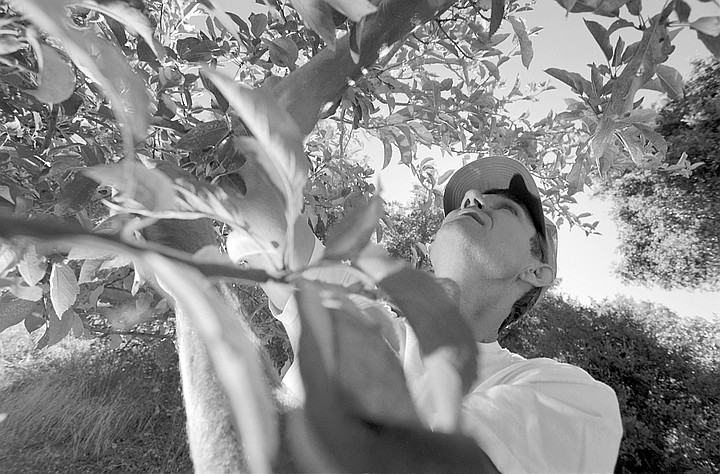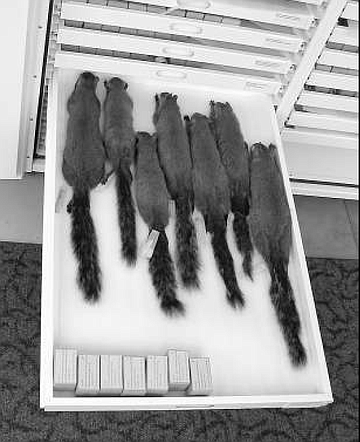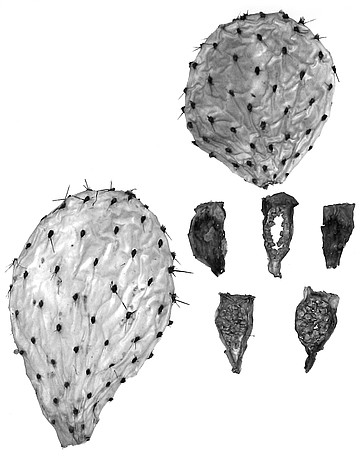 Facebook
Facebook
 X
X
 Instagram
Instagram
 TikTok
TikTok
 Youtube
Youtube

You can't use your nose to find the ranch because the sharp ammonia odor you may associate with chicken farms is absent. Harold Hilliker, second-generation owner of Hilliker's Egg Ranch, explains why. "It's called the coning and drying method. The manure piles up and it cones. The more surface area it has, the faster it dries."
By Ernie Grimm, Dec. 13, 2001 | Read full article

It's hot and it's dry in Bear Valley, in the foothills northeast of Escondido. The grass in the fields crackles underfoot. The live oaks on the hillsides and in the barrancas appear half dead, a mix of brown and green foliage hanging from their boughs. But the ostriches on David Stepp's ostrich farm don't seem to mind the midday August sun beating down on them. Instead of huddling in the shade the way cows and horses do, they stand out in the open, occasionally dipping their heads to root around in the sandy soil with their rounded beaks.
By Ernie Grimm, Sept. 19, 2002 | Read full article

"I've got Northern Spy that I'm almost sold out of. They're known better on the East Coast; wonderful, tart cooking apple. Some people love to eat them. I've got a few Arkansas black, Mammoth Black Twig, a few Pippins yet. Pippins used to be a big apple, but they're going obsolete now. They used to be the green apple you got in the store. Now Granny Smith is taking over. I've got some Lady apples, which is another antique variety. At first I thought, 'What am I going to do with those Lady apples?' But they sell. They're a little flat apple, a little bigger than a crab apple, kind of bland-sweet. And they keep forever.
By Ernie Grimm, Nov. 8, 2001 | Read full article

Scott Treemore, 37, is a research assistant at the Natural History Museum in Balboa Park. He has been studying squirrels for the last four years. "You'll find arboreal [tree] squirrels mostly in the coniferous forests in the backcountry and some of the local inland areas, particularly at higher elevations. It's the western gray squirrel and it's the common squirrel that people see that lives in the trees. Their populations don't normally fluctuate, but they were hit with a virus three years ago, and their population crashed. Now they're slowly coming back.”
By Robert Kumpel, Oct. 31, 2002 | Read full article

San Diegans who refer panhandlers to St. Vincent de Paul Village or the Rescue Mission may not know about San Diego's local canyons.
Jon Rebman, the curator of botany at San Diego's Natural History Museum, says that much of the plant life that grows in San Diego's canyons and back yards is perfectly edible…. Most of the cacti have edible fruits. The pads are edible. In Mexico, they call that the nopalitos. And the fruits, or tunas, are extremely edible. Nopalitos are the pads on a couple of species of prickly pears, and they are a major food in Mexico. You can boil them, dice them up and use them with eggs, or eat them alone as a side dish. They're supposed to be good for diabetics."
By Robert Kumpel, Dec. 5, 2002 | Read full article

As the hysteria over the West Nile virus moves westward, California appears to be the inevitable destination of the mosquitoes that carry the deadly virus.
David Faulkner, 51, is a forensic entomologist and a research associate of the Museum of Natural History in Balboa Park: "We have an artificial environment, because we supply our water from outside, and that will restrict the activity of the mosquitoes, which would obviously restrict the spread of the virus. The places where we traditionally have a lot of problems with biting insects would be more of the coastal areas, like the estuaries, because a lot of these mosquitoes are able to survive in brackish water.
By Robert Kumpel, Sept. 5, 2002 | Read full article


You can't use your nose to find the ranch because the sharp ammonia odor you may associate with chicken farms is absent. Harold Hilliker, second-generation owner of Hilliker's Egg Ranch, explains why. "It's called the coning and drying method. The manure piles up and it cones. The more surface area it has, the faster it dries."
By Ernie Grimm, Dec. 13, 2001 | Read full article

It's hot and it's dry in Bear Valley, in the foothills northeast of Escondido. The grass in the fields crackles underfoot. The live oaks on the hillsides and in the barrancas appear half dead, a mix of brown and green foliage hanging from their boughs. But the ostriches on David Stepp's ostrich farm don't seem to mind the midday August sun beating down on them. Instead of huddling in the shade the way cows and horses do, they stand out in the open, occasionally dipping their heads to root around in the sandy soil with their rounded beaks.
By Ernie Grimm, Sept. 19, 2002 | Read full article

"I've got Northern Spy that I'm almost sold out of. They're known better on the East Coast; wonderful, tart cooking apple. Some people love to eat them. I've got a few Arkansas black, Mammoth Black Twig, a few Pippins yet. Pippins used to be a big apple, but they're going obsolete now. They used to be the green apple you got in the store. Now Granny Smith is taking over. I've got some Lady apples, which is another antique variety. At first I thought, 'What am I going to do with those Lady apples?' But they sell. They're a little flat apple, a little bigger than a crab apple, kind of bland-sweet. And they keep forever.
By Ernie Grimm, Nov. 8, 2001 | Read full article

Scott Treemore, 37, is a research assistant at the Natural History Museum in Balboa Park. He has been studying squirrels for the last four years. "You'll find arboreal [tree] squirrels mostly in the coniferous forests in the backcountry and some of the local inland areas, particularly at higher elevations. It's the western gray squirrel and it's the common squirrel that people see that lives in the trees. Their populations don't normally fluctuate, but they were hit with a virus three years ago, and their population crashed. Now they're slowly coming back.”
By Robert Kumpel, Oct. 31, 2002 | Read full article

San Diegans who refer panhandlers to St. Vincent de Paul Village or the Rescue Mission may not know about San Diego's local canyons.
Jon Rebman, the curator of botany at San Diego's Natural History Museum, says that much of the plant life that grows in San Diego's canyons and back yards is perfectly edible…. Most of the cacti have edible fruits. The pads are edible. In Mexico, they call that the nopalitos. And the fruits, or tunas, are extremely edible. Nopalitos are the pads on a couple of species of prickly pears, and they are a major food in Mexico. You can boil them, dice them up and use them with eggs, or eat them alone as a side dish. They're supposed to be good for diabetics."
By Robert Kumpel, Dec. 5, 2002 | Read full article

As the hysteria over the West Nile virus moves westward, California appears to be the inevitable destination of the mosquitoes that carry the deadly virus.
David Faulkner, 51, is a forensic entomologist and a research associate of the Museum of Natural History in Balboa Park: "We have an artificial environment, because we supply our water from outside, and that will restrict the activity of the mosquitoes, which would obviously restrict the spread of the virus. The places where we traditionally have a lot of problems with biting insects would be more of the coastal areas, like the estuaries, because a lot of these mosquitoes are able to survive in brackish water.
By Robert Kumpel, Sept. 5, 2002 | Read full article
Comments